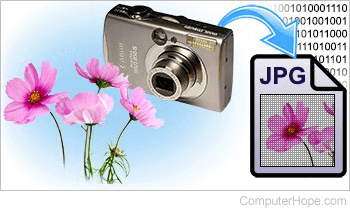Digitizer

A digitizer is a hardware device that receives analog information, such as sound or light, and records it digitally. Usually, the information is stored in a file on a computing device. This process is called digitization.
For example, a digital camera is a digitizer. Light enters through the camera lens, and the hardware and software inside the camera converts that information to binary data, and stores it an image file. The user may then transfer the file to a computer, where he or she can edit the image, print it out, or share it online.
The"digital information age" is said to have begun in 2002, which was the year that total digitized information in the world exceeded traditional analog information. As of 2023, according to statista, the estimated total size of data expected to be consumed was 120 zettabytes.
Examples of digitizers
A digital camera is one example of a digitizer. Other examples include:
Audio digitizer
Most computers have a microphone jack, where you can connect an analog microphone. The analog input (the audio signal) is processed in the computer by a discrete sound card, or by audio hardware on the motherboard itself. This data can then be used by software running on the computer. Some audio digitizers are small hand-held devices, and some are expensive peripherals that provide professional-level conversion quality. The microphone in a smartphone is another audio digitizer.

Digital Tablet
A tablet is a computing device that is controlled with a finger or a digital pen called a stylus. A tablet is usually larger than a smartphone, but smaller than a computer monitor. Some tablets have a screen, which is touched directly, and some tablets are peripheral devices, without screens, which attach to a computer. The user can write, draw, and paint by touching the tablet. Software converts the analog touch input to lines or pressure-sensitive brush strokes in a document. The software may also perform handwriting recognition to convert handwritten text to typewritten words. Devices that deal with hand-drawn images are called graphics tablets.

Accelerometer and gyroscope
Digitizers inside smartphones and tablet computers can detect how fast the device is moving (an accelerometer), and the angle it's held (a gyroscope). The analog information of motion and angular rotation is converted to data your apps can use in real time. For example, using a gyroscope, a smartphone could be held up to the sky to receive information about the position of stars and planets. The accelerometer helps reduce motion blur when you're taking a photo, and can trigger safety mechanisms if the device is accidentally dropped.
Scanner
A scanner is a photographic device, usually stationary, which progressively captures image data. For instance, a flatbed scanner is a peripheral device that takes an image of a document or photograph. It does so by moving a camera beneath a transparent glass surface where the document is placed. A motion picture film scanner digitizes motion picture film frames by advancing the film one frame at a time, photographing the frames, and storing them as a sequence of digital images. A barcode scanner captures binary data by progressively scanning a laser across a printed barcode.
There are other types of digitizers, with more being created every year.
Analog-to-digital converter, Digitize, Graphics tablet, Hardware terms, Input device, Pen tablet, Scanner, Spatial digitizer, Touch screen
